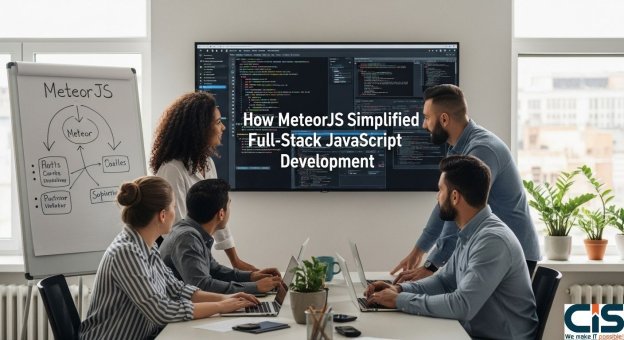
The era before MeteorJS was, frankly, a mess for JavaScript developers. Building a modern web application required stitching together a complex 'Franken-stack': a front-end framework (like Backbone or early Angular), a REST API layer, a server-side framework (like Express/Node.js), and a database. The most painful part? Manually synchronizing data changes across all these layers to achieve a real-time user experience. This complexity directly translated to slower development cycles and higher costs for businesses.
Enter MeteorJS. Launched with the audacious goal of making full-stack JavaScript application development dramatically better and easier, it delivered. Meteor was the first framework to truly unify the entire stack, from the database to the client, under a single language and a revolutionary data synchronization protocol. For CTOs and Product Managers, this meant one thing: unprecedented speed in delivering real-time, engaging applications.
This article explores the core mechanics of how Meteor achieved this simplification, its enduring relevance in the modern 2025 ecosystem, and why it remains a powerful choice for rapid application development.
Key Takeaways for Executive Decision-Makers 💡
- Single Language Simplicity: MeteorJS allows developers to use JavaScript/Node.js for the entire stack (client, server, and database commands), drastically reducing context switching and accelerating development time.
- Real-Time by Default: Its core technology, the Distributed Data Protocol (DDP), provides automatic, real-time data synchronization between the database and the client, eliminating the need for complex, manual API calls for live updates.
- Rapid Prototyping & MVP: The integrated nature of Meteor, including built-in user accounts and a package system, enables the creation of a Minimum Viable Product (MVP) up to 30% faster than traditional multi-framework stacks.
- Modern Relevance: With the recent Meteor 3.x updates, the framework has modernized its core (Node.js 20+, async/await), ensuring it remains a viable, high-performance option for enterprise-grade, real-time applications.
The Core Problem: Why Traditional JavaScript Stacks Were Slow 🐢
Before Meteor, the standard approach to building a dynamic web application involved a fundamental disconnect between the client and the server. This architecture, while robust, was inherently inefficient for modern, interactive applications:
- Context Switching Overhead: Developers had to master and switch between multiple languages: JavaScript for the frontend, a different language (like Java or PHP) for the backend, and SQL for the database.
- Manual Data Synchronization: Every data change required a manual, explicit request (a REST API call) from the client to the server, and then another manual update to the client's UI. This was the primary bottleneck for building real-time features like live chat, collaborative editing, or financial dashboards.
- Code Duplication: Business logic often had to be written twice: once on the server for security and once on the client for a responsive user experience.
This fragmentation made the process of A Complete Guide To Web Application Development a protracted, resource-intensive effort, particularly when compared to the unified approach offered by Meteor.
Meteor's Three Pillars of Simplification: The 'Better & Easier' Mechanics ✨
Meteor didn't just offer a new library; it introduced a fundamentally new paradigm for full-stack JavaScript framework development. Its simplicity is rooted in three revolutionary concepts that drastically reduced boilerplate code and development friction.
1. Full-Stack JavaScript & Isomorphism
By running on Node.js, Meteor allowed developers to use a single language-JavaScript-for the entire application. This concept, known as Isomorphic or Universal JavaScript, meant that code could be shared between the client and the server. This eliminated the need for context switching and significantly reduced the risk of bugs from mismatched logic.
2. The Distributed Data Protocol (DDP) and Live Data
This is Meteor's secret weapon. DDP is a WebSocket-based protocol that manages real-time communication. Instead of the client constantly polling the server for updates, the server pushes data changes to the client instantly. This is the essence of its reactivity. When a user updates a record in the database, DDP ensures every connected client sees that change in milliseconds, without a page refresh. This is a game-changer for user experience and a massive time-saver for developers.
3. Integrated Ecosystem ('Batteries Included')
Meteor was designed to be a complete platform. It came with a built-in package system, a build tool, and essential packages for user accounts, routing, and database integration (MongoDB). This 'convention over configuration' approach meant developers could skip weeks of setup and jump straight into building features.
| Pillar | Mechanism | Business Value for CTOs |
|---|---|---|
| Single Language | Isomorphic JavaScript (Node.js) | Reduced hiring complexity, lower context-switching costs. |
| Real-Time by Default | Distributed Data Protocol (DDP) | Superior, highly engaging user experience (UX) without custom API work. |
| Integrated Tooling | Built-in Build System, Accounts, MongoDB | Faster time-to-market (MVP in weeks, not months). |
Quantified Benefits: Speed, Cost, and User Engagement 🚀
For business leaders, the technical elegance of Meteor translates directly into measurable business advantages. The framework's design is a blueprint for efficiency, which is a critical factor in Cloud Application Development Can Help In Cost Saving and overall project ROI.
- Accelerated Time-to-Market: Because of the unified stack and built-in features, development teams can focus 100% on business logic. According to CISIN's internal project data, using a unified framework like Meteor can reduce the time required to launch a feature-complete MVP by up to 35% compared to a traditional, fragmented stack.
- Reduced Codebase and Maintenance: Less code means fewer bugs. The automatic reactivity of DDP eliminates thousands of lines of manual data-fetching and state-management code. This directly lowers long-term maintenance costs.
- Enhanced User Experience (UX): Real-time updates are no longer a 'nice-to-have' but an expectation. Meteor delivers this by default, leading to higher user engagement and retention rates, particularly for collaborative platforms, FinTech dashboards, and live tracking applications.
The choice between a unified platform like Meteor and a fragmented stack is often the difference between a six-month and a four-month launch window. For a startup or a new product line, that speed is a competitive advantage.
Is your application development speed a bottleneck for market entry?
The complexity of fragmented stacks is costing you time and money. A unified, expert-led approach is the solution.
Accelerate your MVP launch with our specialized Full-Stack Development PODs.
Request Free Consultation2025 Update: Meteor's Modern Relevance and Enterprise Integration 🌐
A common skepticism among CTOs is whether MeteorJS, an established framework, remains relevant in the age of modern React, Vue, and specialized microservices. The answer is a resounding yes. The Meteor Core Team has aggressively modernized the platform, ensuring its longevity and enterprise readiness.
- Meteor 3.x Modernization: Recent major updates have focused on removing legacy components (like Fibers) and adopting native JavaScript features (async/await), bringing the framework up to date with the latest Node.js versions (v20+ and beyond). This ensures performance, security, and compatibility with the modern Node Js Vs Java For The Enterprise Web Applications Development ecosystem.
- Frontend Flexibility: While Meteor originally favored its own view layer (Blaze), it now seamlessly integrates with all major modern frontends, including React, Vue, and Svelte. This allows enterprises to leverage their existing frontend talent while benefiting from Meteor's powerful backend and real-time capabilities.
- Microservices and GraphQL: For large-scale enterprise applications, Meteor is no longer a monolithic constraint. It is now frequently used as a powerful, real-time microservice, easily integrating with other systems via REST or, increasingly, GraphQL (using the Apollo integration). This allows for seamless connection to critical enterprise platforms like Salesforce Application Development or custom ERPs.
The modern Meteor is the best of both worlds: the simplicity and speed of a full-stack framework combined with the flexibility and performance required for enterprise-grade solutions.
Partnering with CIS: Elevating Your MeteorJS Project to Enterprise Scale 🤝
While MeteorJS simplifies development, scaling a real-time application to handle millions of concurrent users and integrating it with complex enterprise systems requires specialized expertise. This is where Cyber Infrastructure (CIS) steps in as your strategic technology partner.
Our 100% in-house, vetted, expert talent has deep experience in full-stack JavaScript, Node.js, and MongoDB, which are the core technologies of Meteor. We don't just write code; we architect solutions that are scalable, secure, and future-proof.
CIS's Strategic Advantage for MeteorJS Projects:
- Performance Engineering: We move beyond the default setup, implementing advanced scaling techniques like Redis Oplog to ensure your DDP-based application maintains peak performance under heavy load.
- Enterprise System Integration: Our expertise in system integration ensures your Meteor application communicates flawlessly with your existing ERP, CRM, and legacy systems, turning a standalone app into a core business asset.
- Secure, AI-Augmented Delivery: We adhere to verifiable process maturity (CMMI Level 5, ISO 27001) and use AI-augmented tools to enhance code quality and security, giving you peace of mind.
- Flexible Engagement: Whether you need a dedicated MEAN/MERN Full-Stack POD for rapid development or a fixed-scope project, our billing models (T&M, Fixed-Fee, POD) are designed to align with your business goals.
The Enduring Legacy of MeteorJS in Application Development
MeteorJS was a pivotal moment in the history of JavaScript, proving that full-stack development could be simple, fast, and inherently real-time. While the ecosystem has evolved, its core value proposition-unifying the stack for rapid, engaging application delivery-remains unmatched for many use cases. For CTOs and Product Managers seeking to minimize time-to-market and maximize developer productivity, a modern Meteor stack, expertly implemented, is a powerful strategic choice.
Article Reviewed by CIS Expert Team: This content is informed by the strategic insights of Cyber Infrastructure's leadership, including our Technology & Innovation experts. As an award-winning AI-Enabled software development and IT solutions company since 2003, with CMMI Level 5 appraisal and Microsoft Gold Partner status, CIS ensures every solution is built for world-class performance and enterprise scale.
Frequently Asked Questions
Is MeteorJS still a good choice for new application development in 2025?
Yes, absolutely. With the release of Meteor 3.x, the framework has been fully modernized, supporting the latest Node.js versions and native async/await features. It remains one of the most productive frameworks for building real-time, data-intensive MVPs and applications due to its unified stack and built-in reactivity (DDP).
How does MeteorJS compare to a stack like MERN (MongoDB, Express, React, Node)?
The MERN stack is a collection of separate technologies that you must manually integrate. MeteorJS is a cohesive platform that includes all these components (often using MongoDB and Node.js) and integrates them automatically with its real-time DDP protocol. Meteor offers significantly faster initial setup and development speed, while MERN offers more granular control over each layer.
Does MeteorJS scale for large enterprise applications?
While early versions had scaling challenges, modern Meteor applications can scale effectively. Enterprise-level scaling requires specialized DevOps and performance tuning, such as implementing Redis Oplog for distributed data synchronization and leveraging cloud-native architectures. CIS's DevOps & Cloud-Operations Pod specializes in architecting and managing these high-scale deployments.
Ready to leverage the speed of MeteorJS without the scaling headaches?
Don't let the complexity of enterprise integration slow down your real-time application. Our 100% in-house, CMMI Level 5-appraised experts deliver secure, scalable, and high-performance Meteor solutions.



